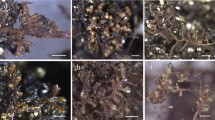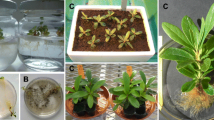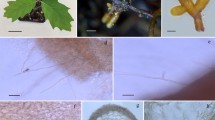Abstract
A filamentous fungus was isolated from Tuber borchii Vitt. fruiting bodies, and it was identified as an Arthrinium phaeospermum (Corda) M.B. Ellis strain, an “endophyte” that forms various associations with healthy leaves, stems, and roots of plants. Molecular analysis confirmed the association of this filamentous fungus with the ascocarps of all collection sites in Salento, Apulia (South Italy). An in vitro symbiosis system between Cistus creticus L. and T. borchii was set up; A. phaeospermum appears to be able to promote mycorrhiza formation in Cistus seedlings, inducing primary root shortening and an increase of secondary roots, similar to the effect of Mycorrhization Helper Bacteria (MHB). Compartmented and uncompartmented bioassays were carried out to investigate the effects of exudates/volatiles released by the truffle-hosted fungus on root architecture; the results showed root shortening in compartmented bioassay suggesting that volatiles released by the fungus alone are sufficient to alter root morphology in early phase of interaction before the mycorrhiza formation. The first evidence for an influence of a truffle-hosted fungus on ectomycorrhizal symbiosis establishment is reported.






Similar content being viewed by others
References
Amicucci A, Zambonelli A, Giomaro G, Potenza L, Stocchi V (1998) Identification of ectomycorrhizal fungi of the genus Tuber by species-specific ITS primers. Mol Ecol 7:273–277
Antony–Babu S, Deveau A, Van Nostrand JD, Zhou J, Le Tacon F, Robin C, Frey-Klett P, Uroz S (2014) Black truffle-associated bacterial communities during the development and maturation of Tuber melanosporum ascocarps and putative functional. Environ Microbiol 16:2831–2847
Barbieri E, Potenza L, Rossi I, Sisti D, Giomaro G, Rossetti S (2000) Phylogenetic characterization and in situ detection of a cytophaga-flexibacter- bacteroides phylogroup bacterium in Tuber borchii vittad. ectomycorrhizal mycelium. Appl Environ Microbiol 66:5035–5042
Barbieri E, Guidi C, Bertaux J, Frey-Klett P, Garbaye J, Ceccaroli P (2007) Occurrence and diversity of bacterial communities in Tuber magnatum during truffle maturation. Environ Microbiol 9:2234–2246
Barbieri E, Ceccaroli P, Saltarelli R, Guidi C, Potenza L, Basaglia M (2010) New evidence for nitrogen fixation within the Italian white truffle Tuber magnatum. Fungal Biol 114:936–942
Barker SJ, Tagu D (2000) The roles of auxins and cytokinins in mycorrhizal symbioses. J Plant Growth Regul 19:144–154
Buzzini P, Gasparetti C, Turchetti B, Cramarossa MR, Vaughan-Martini A, Martini A, Pagnoni MA, Forti L (2005) Production of volatile organic compounds (VOCs) by yeasts isolated from the ascocarps of black (Tuber melanosporum Vitt.) and white (Tuber magnatum Pico) truffles. Arch Microbiol 184:187–193
Ciarmela P, Potenza L, Cucchiarini L, Zeppa S, Stocchi V (2002) PCR amplification and polymorphism analysis of the intergenic spacer region of ribosomal DNA in Tuber borchii. Microbiol Res 157:69–74
Comandini O, Contu M, Rinaldi AC (2006) An overview of Cistus ectomycorrhizal fungi. Mycorrhiza 16:381–395
Deshmukh SK, Verekar SA (2012) Fungal endophytes: a potential source of antifungal compounds. Front Biosci E4:2045–2070
Di Battista C, Amicucci A, Guidi C, Bertini L, Sisti D, Stocchi V (1999) A rapid mini-prep method for isolation of ectomycorrhizal DNA from Tuber species. Biotechnol Tech 13:331–335
Duponnois R, Garbaye J (1991) Effect of dual inoculation of Douglas fir with the ectomycorrhizal fungus Laccaria laccata and mycorrhization helper bacteria (MHB) in two bare root forest nurseries. Plant Soil 138:169–176
Duponnois R, Garbaye J (1992) Some mechanisms involved in growth stimulation of ectomycorrhizal fungi by bacteria. Can J Botany 68:2148–2152
Faeth SH, Fagan FW (2002) Fungal endophytes: common host plant symbionts but uncommon mutualists. Integ Comp Biol 42:360–368
Felten J, Legué V, Ditengou FA (2010) Lateral root stimulation in the early interaction between Arabidopsis thaliana and ectomycorrhizal fungus Laccaria bicolor. Plant Signal Behav 5:864–867
Frey-Klett P, Garbaye J, Tarkka M (2007) The mycorrhiza helper bacteria revisited. New Phytol 176:22–36
Gou J, Strauss SH, Tsai CJ, Fang K, Chen Y, Jiang X, Busov VB (2010) Gibberellins regulate lateral root formation in Populus through interactions with auxin and other hormones. Plant Cell 22:623–639
Iotti M, Zambonelli A (2006) A quick and precise technique for identifying ectomycorrhizas by PCR. Mycol Res II0:60–65
Kagan-Zur V, Raveh E, Lischinsky S, Roth-Bejerano N (1994) Initial association between Helianthemum and Terfezia is enhanced by low iron in the growth medium. New Phytol 127:567–570
Kaska DD, Myllylä R, Cooper JB (1999) Auxin transport inhibitors act through ethylene to regulate dichotomous branching of lateral root meristems in pine. New Phytol 142:49–58
Khan SA, Hamyun M, H-y K, H-j Y, J-c S, Y-s C, Lee I-j, S-d K, I-k R, J-g K (2009) A new strain of Arthrinium phaeospermum isolated from Carex kobomugi Owhi is capable of gibberellin production. Biotechnol Lett 31:283–287
Luisi A, Lorenzi L, Sorce C (2011) Strigolactone may interact with gibberellin to control apical dominance in pea (Pisum sativum L.). Plant Growth Regul 65:415–419
Luppi-Mosca AM (1973) La microflora della rizosfera nelle tartufaie. Allionia 19:29–32
Miozzi L, Balestrini R, Bolchi A, Novero M, Ottonello S, Bonfante P (2005) Phospholipase A2 up-regulation during mycorrhiza formation in Tuber borchii”. New Phytol 167:229–238
Pacioni G (1990) Scanning electron microscopy of Tuber sporocarps and associated bacteria. Mycol Res 94:1086–1089
Pacioni G, Leonardi M, Aimola P, Ragnelli AM, Rubini A, Paolocci F (2007) Isolation and characterization of some mycelia inhabiting Tuber ascomata. Mycol Res III:1450–1460
Paolocci F, Cristofari E, Angelini P, Granetti B, Arcioni S (1995) The polimorphism of the rDNA region in typing ascocarps and ectomycorrhizae of truffle species. In: Stocchi V, Bonfante P, Nuti M (eds) Biotechnology of ectomycorrhizae. Plenum Press, New York, pp 171–184
Poole EJ, Bending GD, Whipps JM, Read DJ (2001) Bacteria associated with Pinus sylvestris- Lactarius rufus ectomycorrhizas and their effects on mycorrhiza formation in vitro. New Phytol 151:743–751
Sbrana C, Bagnoli G, Bedini S, Filippi C, Giovannetti M, Nuti MP (2000) Adhesion to hyphal matrix and antifungal activity of Pseudomonas strains isolated from Tuber borchii ascocarps. Can J Microbiol 46:259–268
Sbrana C, Agnolucci M, Bedini S, Lepera A, Toffanin A, Giovannetti M, Nuti MP (2002) Diversity of culturable bacterial populations associated to Tuber borchii ectomycorrhizas and their activity on T. borchii mycelial growth. FEMS Microbiol Lett 211:195–201
Schrey SD, Schellhammer M, Ecke M, Hampp R, Tarkka MT (2005) Mycorrhiza helper bacterium Streptomyces AcH505 induces differential gene expression in the ectomycorrhizal fungus Amanita muscaria. New Phytol 168:205–216
Splivallo R, Bossi S, Maffei M, Bonfante P (2007) Discrimination of truffle fruiting body versus mycelial aromas by stir bar sorptive extraction. Phytochemistry 68:2584–2598
Splivallo R, Fischer U, Gobel C, Feussner I, Karlovsky P (2009) Truffles regulate plant root morphogenesis via the production of auxin and ethylene. Plant Physiol 150:2018–2029
Tarkka MT, Herrmann S, Wubet T, Feldhahn L, Recht S, Kurth F, Mailänder S, Bönn M, Neef M, Angay O, Bacht M, Graf M, Maboreke H, Fleischmann F, Grams TEE, Ruess L, Schädler M, Brandl R, Scheu S, Schrey SD, Grosse I, Buscot F (2013) OakContigDF159.1, a reference library for studying differential gene expression in Quercus robur during controlled biotic interactions: use for quantitative transcriptomic profiling of oak roots in ectomycorrhizal symbiosis. New Phytol 199:529–540
Tilki F (2008) Seed germination of Cistus creticus L. and Cistus laurifolius L. as influenced by dry-heat, soaking in distilled water and gibberellic acid”. J Environ Biol 29:193–195
Varese GC, Portinaio S, Trotta A, Scannerini S, Luppi-Mosca AM, Martinetti MG (1996) Bacteria associated with Suillus grevillei sporocarps and ectomycorrhizae and their effects on in vitro growth of the mycobiont. Symbiosis 21:129–147
Ventura Y, Mills D, Kagan-Zur V, Roth-Bejerano N, Bustan A (2006) Mycorrhized Ri-trasformed roots facilitate in vitro inoculation of Cistus incanus with Tuber melanosporum”. Plant Cell Tissue Org Cult 85:53–61
White TJ, Bruns T, Lee S, Taylor JW (1990) Amplification and direct sequencing of fungal ribosomal RNA genes for phylogenetics”. In: Innis (ed) PCR protocols: a guide to methods and applications. Academic Press, Inc, New York, pp 315–322
Acknowledgments
Authors thank the Ministry of Education, Universities and Research (MIUR) that provides financial support for the Zeiss LSM 700 laser scanning microscope purchase (Enhancement Project 2HE, Cod. PONa3_00334—CUP F81D11000210007, Project of Structural Enhancement financed by PON R&C 2007—2013, Axis I Operative 4.1.1.4, Action I “Structural Improvement”).
Author information
Authors and Affiliations
Corresponding author
Additional information
Section Editor: Roland Kirschner
Rights and permissions
About this article
Cite this article
Sabella, E., Nutricati, E., Aprile, A. et al. Arthrinium phaeospermum isolated from Tuber borchii ascomata: the first evidence for a “Mycorrhization Helper Fungus”?. Mycol Progress 14, 59 (2015). https://doi.org/10.1007/s11557-015-1083-6
Received:
Revised:
Accepted:
Published:
DOI: https://doi.org/10.1007/s11557-015-1083-6




